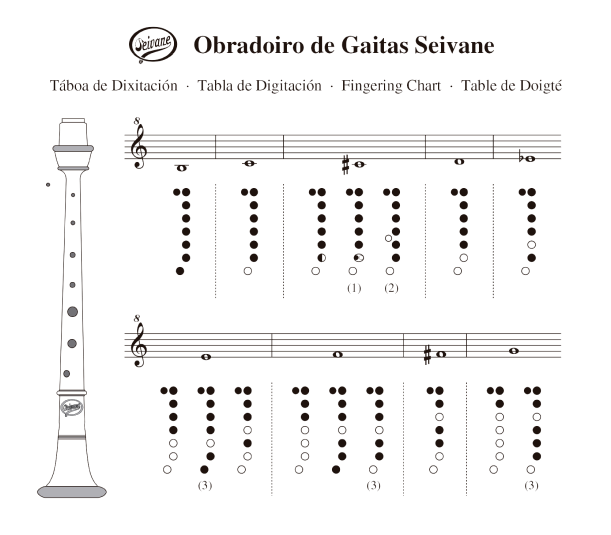- Inicio •
- Documentation •
- Manual & Tips •
Manual & Tips
The following is the information that is included in the instruction manual that accompanies all our gaitas including:
Packaging Content
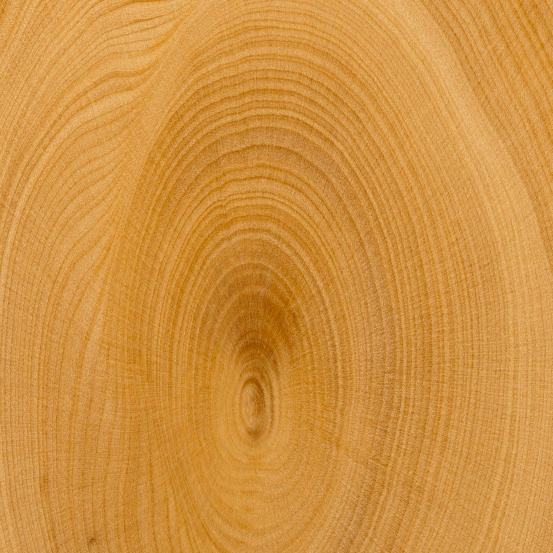
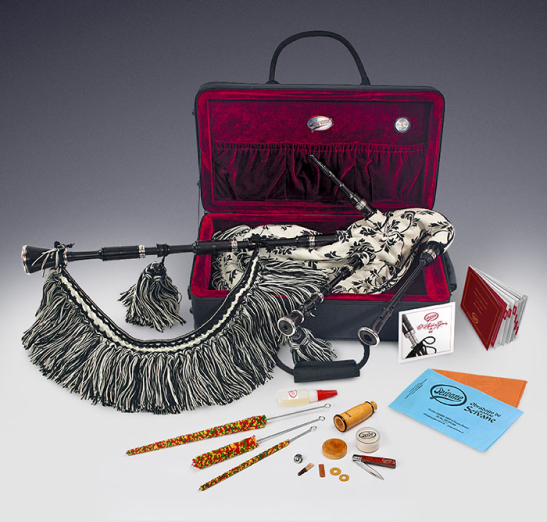
When you open the packaging of your instrument (a rigid cardboard box), you will find the following items enclosed:
Within you can find out many and interesting tricks for the presevation and maintenace of your gaita.
High qulity hard case, designed for comfortable carriage, as well as excellent physical and thermal protection. It offers hygrometer, various external pockets, an area for personal effects and internal cavities for gaita accessories. Thanks to the versatility of its handles, it can be carried over the shoulder or even as a rucksack.
Made and checked by the Obradoiro de Gaitas Seivane with the highest level of quality. Its assembly only requires the parts of the bass drone, separated during transport, to be joined again.
Includes one chanter reed, one valve (Seipón) for the blowpipe, two valves (Seipal) and one button.
Set of three brushes designed especially to clean the internal parts of the gaita: one to remove the condensation in the tuning slides of the bass drone in a humid atmosphere, another one for the blowpipe, and a third one for the chanter.
High quality almond oil, solely for the internal cleansing of the chanter. Do not use it on other parts of the gaita, as it could affect the Seipal and Seipón valves.
It is recommended to apply as per the photograph, three drops through a hole and spread using the cleaning brush. Frequency of use, twice a year.
Despite being in an airtight jar, Seite is vulnerable to heat and we therefore recommend you keep it at home.
Cap made of boxwood, which when placed over the chanter, protects the reed and by adding the detachable mouthpiece from the blowpipe, allows the chanter to be played directly.
To act as a base for the trimming of chanter reeds.
For the general cleaning of the instrument, with the aim of removing the acids that hands leave on it.
A special cloth to shine the metallic ring caps on your gaita (included only in gaita models with metallic ring caps, except Seinox). Other products can be used to clean silver, taking special care not to get them on the wood.
For the scraping and trimming of chanter reeds.
Used especially for the lubrication of corks. Despite being in an airtight case, Seibo is vulnerable to heat and we therefore recommend you keep it at home. Refrigeration is not necessary. As an estimate the Seibo provided with the gaita should last for four to five years.
Audiovisual documentary about Seivane.
Precautions for Use and General Maintenance
Take care when opening the packaging to check that package has not suffered any damage during transport. Check the contents to ensure everything is in perfect condition.
Protect your gaita from the rain, prolonged exposure to sunlight and sudden changes in temperature and humidity.
Never leave your gaita in the boot of car which is in direct sunlight nor on cold nights. This could cause serious damage to the instrument, as well as the obvious risk of theft.
You should never immerse the instrument in any kind of liquid.
Be careful with how you leave your instrument to rest. The cylindrical parts and the bag do not offer a reliable stability for its support and so it could roll or slip.
When manipulating the chanter reed, be careful when removing the chanter from its stock, as any graze against the chanter reed can leave it rendered useless. You should always hold the chanter reed close to the stock (on the bridge). It could break if you do it from the other side. The chanter reed is removed of its slot and inserted into it by a thread system.



You should never grab the chanter by the bell end or by its body to turn it or to try and remove it as it is very easy to break it. One good operating method consists of holding the chanter’s stock with the left hand and the bridge of the chanter with the right hand. With the thumb on the right hand putting some pressure on the stock, turn and, at the same time pull the chanter out with a lot of care until the end of the cork. The thumb on the right hand should coordinate both hands so that the chanter comes out straight and, as a result, the chanter reed will not graze the edges of the chanter stock.
Be very careful with knocks and grazes, as they can help the wood to crack as well as producing a general deterioration in the instrument.
Check that the chanter and drone reeds are inserted firmly in their slots to ensure they are airtight.
When you inflate the bag, try to ensure that you do so in a way that introduces as little humidity as possible. Once the necessary pressure for the acoustic functioning of the gaita has been achieved, try to keep this constant with the help of your arm (tempering). Make reasonable use of the air held inside the bag and avoid over inflating the bag as this will only create an excess of humidity. Remember that the bag is a reserve of air which you have to know how to manage.
If any of drone reeds stop or if the chanter reed does not sound, do not use excess force on the bag as this may damage them. It is better to take the gaita apart and try and find out the cause of the malfunction. The drone reed is calibrated for average pressure. If it stops, a finger must be put on the clamps to avoid breaking them and the reed must be raised by slightly forcing it. If the pitch is lowered, move the clamp until the right pitch is found.
If you are not going to use your gaita for a prolonged period of time, dismantle all parts of the gaita so that, as far as possible, the corks recover their initial elasticity. Remove the chanter and drone reeds and circulate air through the bag to dry out its interior. Once you have ensured there is no longer any humidity, wrap each part of the gaita separately to avoid any scratches and store them in the protective carry case.
This habit of dismantling all parts of the gaita is good advice in short periods of two to three days, in order to achieve a longer life for the corks.
Do not use abrasive materials for the cleaning of your gaita. Always use the supplied yellow cloth for the general cleaning of the wood and ring caps after its use.
In order to preserve the wood, you can use a good furniture product that contains wax. Use the blue cloth for the ring caps (except Seinox) or some kind of product to clean the silver. The blue cloth is soaked in a special dust called ‘Alunita’ which continues to be effective even when it darkens, therefore it is not to be washed.
For the internal cleansing of the gaita, use the internal cleaning kit, made up of the three cleaning brushes and a pot of Seite. Ensure you do not use it on other parts of the gaita, as it could affect the Seipal and Seipón valves. Apply three drops through a hole in the chanter and spread using the cleaning brush. Frequency of use, twice a year.
The Gore-Tex® bag requires no maintenance whatsoever. Its micro-porous cloth transpires, which means that the condensed humidity inside it tends to leave through the pores due to the phenomenon of osmosis. In humid atmospheres, it is recommended that you remove the blowpipe to avoid a build up of humidity when you stop using the gaita. In dry or very dry atmospheres, every now and again you should introduce a small quantity of water (half a glass: 5 or 6 cl.) inside the bag once all the sound components have been detached from the bag and the stacks have been covered off. This helps to impregnate the internal walls with the aim of maintaining a slight level of humidity which is beneficial to the chanter reed.
If the valve in the blowpipe ceases to be effective, it should be replaced. Remove the nail that holds it in place with some pliers or tweezers and dispose of the defective valve. The support on the nail should apply a minimal amount of pressure on the valve. If your gaita has the new Seipón system, you may change the old valve for a new one and, in this case, it will be enough to tie it with some thread without applying too much pressure.
It is advisable to carry out an exercise that is very good for the instrument: Each time you finish using the gaita, remove the blowpipe from its stock and shake it energetically to remove the humidity that the valve retains. It is recommended that you do not place the blowpipe back in its stock until you use the instrument again, as this way, the humid air that remains in the bag has a more effective escape route thus prolonging the life of the sound pipes as well as that of the valve itself.
The corks should be greased lightly, you should not apply too much, with lamb or goat fat or with special grease known as Seibo’. To the corks of drones where they meet the stocks, be specially moderate to avoid they turn when tuning. If, for any reason, any tuning slide becomes too tight in its hole, hold a piece in each hand (do not use tools which may mark the wood) and turn them in opposite direction whilst at the same time making small movements to and fro, as if you were removing the cork from a bottle of cava. The corks which seal the union to the different parts of the gaita have a limited lifetime. If they loosen, break off or unstick, wrap them provisionally with thread until you send the instrument to the Obradoiro de Gaitas Seivane to replace them for new ones.
A correct position of the gaita contributes to the gaiteiro’s comfort, their control and command of the bag, and their appearance.
Your gaita should be used and maintained with certain regularity because, as with any instrument made of wood, it reaches its sonar plenitude after a period of usage.



Description of Parts that make up the Instrument
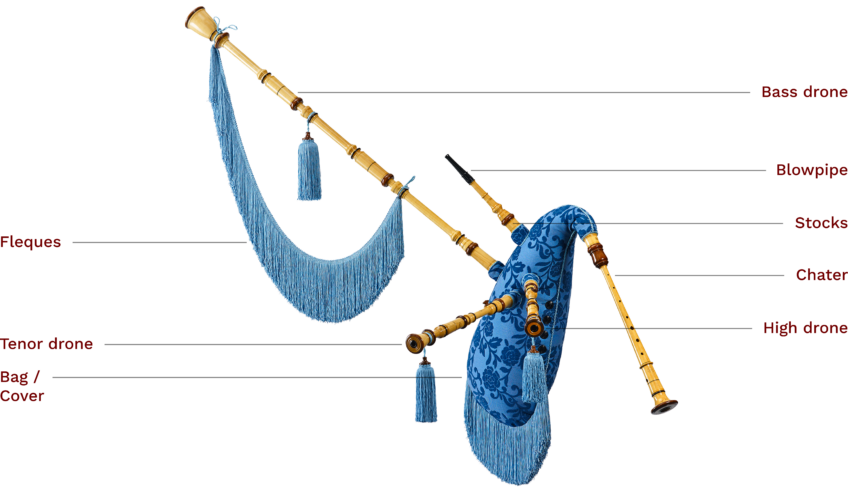
The gaita consists of the following parts (depending on configuration):
The bass drone is made up of three parts (prime, second and cup) linked between them by the tuning slides, which are also useful to tune the bass drone at the same time. It provides a deep and constant pedal note (two octaves below the chanter’s keynote), which harmoniously supports the melody. Its source of sound is a drone reed: A small tube with a simple vibrating plate.
The tenor drone consists of two parts and, like the drone reed, emits a continuous note but this time one octave below the chanter’s keynote. It also has a drone reed as its source of sound.
The tenor drone can have a key to start or stop the flow of air (cutting the sound).
EThe traditional high drone has, as its source of sound, a double plate reed like the chanter. It emits the dominant note in unison with the chanter and so, being a fifth above the keynote, results in it adding great harmonious value to some melodies. It is characterised fundamentally by the intensity of its ‘enxebre’ (authentic) sound and for the discords with neighbouring notes, especially in the sixth minor. It can give the impression that two gaitas are playing together as a duet, especially in open spaces.
After a process of study and investigation, the Obradoiro de Gaitas Seivane has commercialised, since the 1980s, the latest high drone, which uses a small drone reed as its source of sound. Its physical and acoustic characteristics are different, compared to the chanter reed high drone, despite the fact that it emits the chanter’s dominant note, albeit one octave lower. In this way, the discords are reduced to a minimum or cease to exist. Its volume is much smoother and melodic, given that its relationship to the chanter’s keynote is different: A strict four notes below.
There is another high drone, which also uses a drone reed, but which is little used by the Obradoiro de Gaitas Seivane. It emits the chanter’s keynote in the same octave. The main problem is its discord with the leading note, as well as not providing much in a harmonious sense, as it repeats the keynote in the same way as the bass and tenor drones.
The high drone can have a key to start or stop the flow of air (cutting the sound).
This is the part of the gaita that produces the melody. It has a conical interior -unique to Atlantic bagpipes- with eight melodic holes and three more known as ‘sonar ears’. Its source of sound is a double plate reed, similar to those in the fagot, which produces a strong sound full of harmonics.
A small thread at the base of the reed, allows it to be well secured and avoids it falling into the bag. In order to fit the reed, turn it to the right and to remove it, turn it to the left.
If you have Seitor, a chanter that incorporates a new system of tonal regulation, you will be able to correct eventual tonal variance, without having to remove the chanter from the gaita.
These are the parts that join the sound components and the blowpipe with the bag, to which they are firmly tied and through which air flows in or out.
The patented synthetic Seipal drone reed, with the built-in stop valves, is the result of long tem research by the Obradoiro de Gaitas Seivane for tonal stability in any humidity and temperature conditions, though retaining the sound of a traditional cane drone reed.
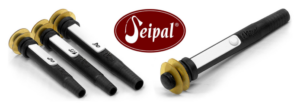
It is the essential part of the gaita that characterises it and differentiates it the most. It performs the task of storing air that enters through the blowpipe and it distributes it to the sound components -chanter, bass drone, tenor drone and high drone- with a pressure that is controlled by the bagpiper’s arm. Good tuning and tempering depend, to a large degree, on this pressure.
Traditionally it was made from goat’s skin, but, for years now, cow’s skin is also used or, more recently, Gore-Tex®.
A cover of textile material which covers and protects the bag, at the same time as giving it shape, consistency and an improved appearance. The choice of fabric and colours tends to define the personality of the bagpiper.
Decorative tassels and fringes matching the bag.
It allows air to be blown into the bag, avoiding it flowing back out through the use of a retention valve. A new valve system known as ‘Seipón’ has recently been developed which, in addition to other advantages, increases reliability and allows quicker and more straightforward replacement.
The new models have a detachable and interchangeable mouthpiece which aids its cleaning and which can be changed over for others of equal or different lengths. When inserted into the boxwood cap, the chanter can be played directly.
In order to remove the mouthpiece from the blowpipe, a good technique that helps to avoid cracks, is to remove the mouthpiece in alignment with the body of the blowpipe, avoiding excessive force or an uncontrolled lateral strain.
It is the most delicate and fussy part of the gaita and is made up of two cane plates, tied on top of a metallic tube known as the ‘tudel’. Produces the source of sound in the chanter.
The drone reed is the element that produces the source of sound in the bass drone, tenor drone and high drone, according to which is used. The traditional drone reed is a single piece cane tube, to which a vibrating plate is cut on the tube itself.

Key
The Obradoiro de Gaitas Seivane makes gaitas in all tonalities, from C4 to G5. Besides, with the key changing kits there is the possibility to change the gaita’s key by exchanging or adding some pieces. Please ask us about.
Gaita Fingering
The following video shows the table of fingering positions, for a gaita tuned in C. For other keys and for practical reasons, the same note name will be used, although its sound will be different.
There are notes with various fingering positions, sometimes with micro-tonal differences between them, which can prove tricky when correcting tuning with precision, depending on the circumstances and situation (chanter reed, chanter, climate…). Either way, they allow the tempered scale to be achieved allowing you to play alongside classical instruments that use it, or they can be used for reasons of comfort in certain passages that are played.
With natural fingering in order, without the use of ‘tranquillas’ (positional adjustment of the fingers on the chanter), the semi-tempered scale is obtained, which is the current natural tuning of the Galician gaita and is halfway between the natural scale , congenital to the old gaita and the modern tempered scale.
If you wish, you can download a PDF version of the printed fingering chart which is sent with every gaita:
Basic suggestions for the adjustment of the chanter reed
For various reasons and on particular occasions, you may find that the chanter is not tuned correctly because of an imbalance in its scale, due to the emergence of higher or lower tonal deviations in the high part of the chanter with reference to its keynote. The most common cause tends to be the particular whims of the chanter reed, as environmental conditions have a very direct effect on them. Sometimes it is possible to correct these deviations by playing for some time to acclimatise the chanter reed and chanter, but this does not always work. A new chanter reed will usually need readjustment whilst a used chanter reed tends to be more stable. However, there comes a time when it will reach a period of tiredness, when it is then recommended that it be adjusted once more in order to continue using it.
Moxenas pronounced that “The bagpiper spends half his life tuning and the other half playing out of tune”. Although at the present time this is, in general, less true, this assertion should be understood as the concern and meticulous nature of the bagpiper in order to control the tuning of his instrument, as this determines his overall success and level of satisfaction.



If the entire scale of the chanter is too high, you should add some thread, Teflon or a thin piece of paper to lift it slightly from its slot. You can bring the tuning lower by scraping the chanter reed a little which, at the same time, also makes the chanter reed softer and thus requires less pressure to make it sound.
If you observe that, with the keynote centered, from G (the fifth), the scale seems too high, you should scrape the rear of the chanter reed lightly and push it further into its slot. With this small refinement of the rear the general tone comes down but in a more pronounced way in the top half of the chanter. You should be careful not to overdo the scraping. This deviation in the top half can also be produced if the cane plates are too closed and very dry. The solution: Open them and moisten them slightly.
If only the high B and high C sound too high, you should only scrape from the middle area to the edge of the chanter reed, or open it slightly.
If the opposite occurs, that is to say, that the top half is too low compared to the keynote, it could be due to:
A chanter reed that has been used too much or has been scraped too much: It should be trimmed.
It has not been inserted far enough: Insert further.
Its plates are too far apart: Adjust accordingly.
It is too wide. File or sand the plates to reduce their width.
If the entire scale is too low: An inadequate chanter reed, one that is too wide, too long or too old. If it is too long, you can trim it, if it is too wide, you can attempt to narrow it somewhat but, in the other two cases, you will need to use a new one. Another reason why the general tuning may be low is the excessively low temperature of the chanter. The solution is simple: Let it become warm gradually.
These basic ideas should be learnt to later combine them, experimenting, until you obtain the most appropriate solution each time.

A very good and hitherto unheard of trick, is to tie the plates with thread as in the main threading, from the metallic regulator upwards. This allows us, adding more or less thread, to increase the tone. It is a very effective trick, especially when it is cold or with chanter reeds that sound too low and that, to make them sound higher, would require them to be cut a great deal which would also cause deviations.

The Seivane Garantee
Obradoiro de Gaitas Seivane can offer the assurance to its user that one has a product of the highest quality in his/her hands.
